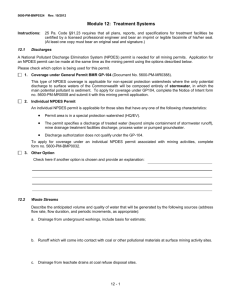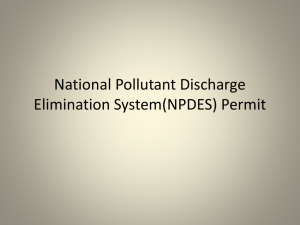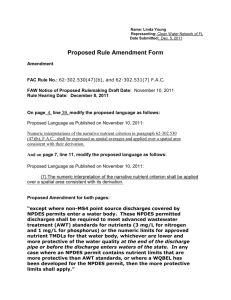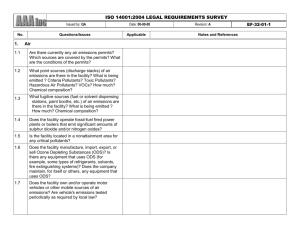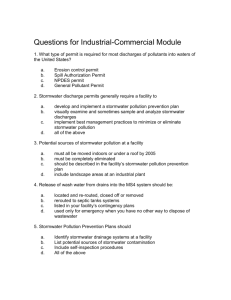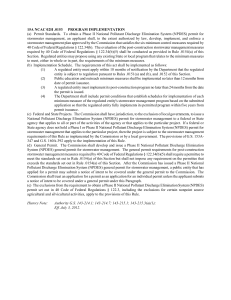Compliance with Stormwater Regulations
advertisement
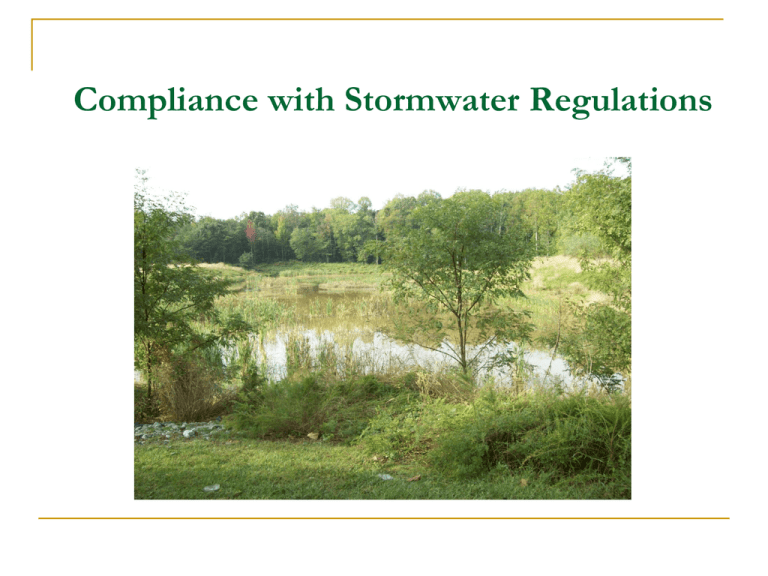
Compliance with Stormwater Regulations
Module Topics
The Clean Water Act (CWA)
National Pollutant Discharge Elimination System
(NPDES) Program
EPA Stormwater Multi-Sector General Permit
(MSGP)
Testing and Sampling
State Specific General Permit
The Clean Water Act (CWA)
The Clean Water Act (CWA)
The cornerstone of surface water quality protection in the
United States
Employs a variety of regulatory and non-regulatory tools
does not deal directly with ground water nor with water quantity
issues
to sharply reduce direct pollutant discharges into waterways
finance municipal wastewater treatment facilities
manage polluted runoff
Achieve the broader goal of restoring and maintaining the
chemical, physical, and biological integrity of the nation's
waters
Major CWA Programs
Water quality standards
Antidegradation policy
includes three major components: designated uses, water quality
criteria, and antidegradation provisions
policy designed to prevent deterioration of existing levels of good
water quality
Waterbody monitoring and assessment
ambient monitoring is also needed to ensure that this is the case
Major CWA Programs
Reports on condition of the Nation’s waters
Total maximum daily loads (TMDLs)
a strategy to meet water quality standards,
TMDLs determine what level of pollutant load would be
consistent with standards
also allocates acceptable loads among sources of the
relevant pollutants
Major CWA Programs
NPDES permit program for point sources
Section 319 program for nonpoint sources
pollution that, unlike pollution from industrial and sewage
treatment plants, comes from many diffuse sources
Section 404 program regulating filling of wetlands and other
waters
lands where saturation with water is the dominant factor
determining the nature of soil development and the types of plant
and animal communities living in the soil and on its surface
(Cowardin, December 1979)
Major CWA Programs
Section 401 state water quality certification
requires federal agencies to obtain certification from the state,
territory, or Indian tribes before issuing permits that would result
in increased pollutant loads to a waterbody
State revolving loan fund (SRF)
provides large amounts of money in the form of loans for
municipal point sources, nonpoint sources, and other activities
Clean Water Act Goals and Standards
Section 101(a)(2): Establishes “fishable and swimmable” goal
Section 303(c): Establishes framework for water quality standards
program and requires States to establish water quality standards
Section 304(a): Requires EPA to
develop and publish recommended
water quality criteria
Section 301(b)(1)(C): Requires
compliance with limits necessary to
meet water quality standards
Healthy Waters Start with
Water Quality Standards
Standards and guidelines are established to
protect water for designated uses such as:
drinking,
recreation,
agricultural irrigation, or
protection and maintenance of aquatic life.
Other standards include:
Protection of aquatic life, including fish, and
fish-eating wildlife such as birds
Healthy Waters Start with
Water Quality Standards
Standards also drive water quality restoration
activities:
By determining which waterbodies must be
addressed
Identifying what level of restoration is necessary
Which activities need to be modified to ensure
that the waterbody meets its minimum
standards
By designating one or more beneficial uses for
each waterbody and establishing a set of
criteria that protect those uses
Regulatory Hierarchy
Clean Water Act
(Congress)
Code of Federal Regulations
(EPA)
NPDES Permits
(EPA, States)
Policy and Guidance
National Pollutant Discharge
Elimination System (NPDES)
Program
National Pollutant Discharge
Elimination System (NPDES)
The CWA made it unlawful to discharge any
pollutant from a point source into navigable waters,
unless a permit was obtained
NPDES
A national program under Section 402 of the Clean
Water Act for regulation of discharges of pollutants
from point sources to waters of the United States
Discharges are illegal unless authorized by an NPDES
permit.
Types of Permits
Specific NPDES program areas applicable to
industrial sources are:
Process Wastewater Discharges
Non-process Wastewater Discharges
Industrial Stormwater Program
NPDES in the Ready Mixed Concrete and
Aggregates Industry
As authorized by the
Clean Water Act, the
National Pollutant
Discharge Elimination
System (NPDES) permit
program controls water
pollution by regulating
point sources that
discharge pollutants into
waters of the United
States.
What Exactly is an NPDES Permit?
It is a license . . .
Issued by the government to persons conducting
business in the United States
Granting permission to do something which would
be illegal in the absence of the permit
There is no right to a permit and it is revocable for cause
(non-compliance)
An NPDES permit is a license to discharge
Definition of Discharge
In its simplest concept, discharge means outflow and is used as a
measure of the rate at which a volume of water passes a given point
it can be used to describe the flow of water from a pipe or a
drainage basin
stormwater discharge
Any water runoff, snowmelt runoff, surface runoff, or
drainage that comes into contact with industrial or
commercial operations/activities and enters the waters of
the United States or a municipal separate storm sewer
system.
NPDES Statutory Framework
All point sources
discharging pollutants
into waters of the
U.S./State
Must obtain
an NPDES
permit from
EPA or an
authorized
state
Authorized State Programs
Blue – NPDES obtained from EPA, Others – NPDES obtained from State Programs
Who Must Apply for a NPDES Permit?
Anyone who discharges pollutants
or proposes to discharge pollutants
to waters of the U.S. [122.21(a)]
Authorization to Discharge Under the
NPDES
The Clean Water Act prohibits anybody from discharging
"pollutants" through a "point source" into a "water of the United
States"
unless they have an NPDES permit
Point Source Discharges
Discrete conveyances, such as pipes or man made ditches that
discharge pollutants into waters of the United States
The permit contains limits on what can be discharged, monitoring
and reporting requirements, and other provisions to ensure that
the discharge does not hurt water quality or people's health
In essence, the permit translates general requirements of the
Clean Water Act into specific provisions tailored to the operations
of each person discharging pollutants
Two Types of Permits
Individual
requires facilities to submit detailed application forms on which
the permitting authority develops a facility-specific NPDES permit
General
EPA's industrial stormwater general permit is known as the multisector general permit (MSGP)
Many States have an equivalent general permit
For example: Maryland has a Mineral Mine Permit
Covers a wide range of industrial and commercial activities and
includes requirements that apply more broadly to this type of
dischargers
Must first develop a Stormwater Pollution Prevention Plan
(SWPPP)
Submit a Notice of Intent (NOI)
Permit generally good for five years
Types of NPDES Discharges
Stormwater
Process Water
Wastewater
Total Suspended Solids (TSS)
Settleable Solids (SS)
pH
Oil and grease
Combined Discharge
Effluent Limits
Stormwater Runoff
Stormwater is the runoff
generated from rain,
melting snow, or other
forms of precipitation
Polluted stormwater runoff
is a leading cause of
impairment to the nearly 40
percent of surveyed U.S.
waterbodies which do not
meet water quality
standards
Point Source Stormwater Discharge
Associated with Industrial Activity
The discharge from any conveyance which is
used for collecting and conveying stormwater
and which is directly related to
manufacturing, processing, or raw materials
storage area at an industrial plant
Common Sources of Pollutants from
Stormwater Runoff
Uncovered outside fuel dispensing
Uncovered outside vehicle maintenance
Contaminated or oil soaked pallets
Open dumpsters or compactors
Compressor or cooling system blow down discharging onto the
ground or into the sewer
Uncovered loading dock platforms
Uncovered storage tanks
Outside storage of chemicals and/or empty containers
Visible materials on roofs, driveways or sides of buildings
Equipment stored outside or uncovered (machine fluids, oil, and
grease)
Piles of material, including dirt, sand, aggregates, etc.
Process Water
Process Water – the
wastewater generated
from various processes
at a facility
Washing of
aggregates
Truck washing
Mobile equipment
cleaning stations
Process Water
Sand and gravel wash water
Quarry dewatering
Dust control water
Equipment wash water
Wheel wash water
Combined Discharge
When stormwater mixes with process water,
then the mix must be treated as process
water
Effluent Limits
Any restriction imposed on quantities, discharge
rates, and concentrations of "pollutants" which are
"discharged" from "point sources" into "waters of
the United States," the waters of the "contiguous
zone," or the ocean.
EPA Stormwater Multi-Sector
General Permit (MSGP)
EPA Multi-Sector General Permit (MSGP)
2008 MSGP
Effective on September 29, 2008 (Re-Issued)
Covering 29 Industrial Sectors
Sector E - GLASS, CLAY, CEMENT, CONCRETE, AND GYPSUM PRODUCTS
Sector J - MINERAL MINING AND DRESSING
EPA Regions Covered
Alaska
Idaho
New Mexico
New Hampshire
Massachusetts
DC
U.S. Territories (except Virgin Islands)
EPA Multi-Sector General Permit
(MSGP)
The MSGP regulates the discharge of stormwater from an
estimated 4,100 industrial facilities in 29 different industrial
sectors
The final permit offers several changes from the MSGP 2000,
including a reorganized permit that clearly spells out:
requirements affecting the installation of stormwater
controls to meet technology-based and water quality-based
effluent limits
inspection and effluent monitoring requirements
development of the stormwater pollution prevention plans
(SWPPPs)
EPA Multi-Sector General Permit
(MSGP)
New requirements to annually report inspection findings and
the results of corrective actions to EPA
Improved tools for identifying receiving waters and notifying
EPA of the location of impaired waterbodies and the
pollutants of concern
Fast and easy electronic submission of Notice of Intent (NOI)
through the e-NOI system operated by Headquarters
with automated e-mail explanations and reminders of
monitoring requirements
Electronic submission of monitoring results under the e-NOI
system
Notice of Intent
Electronic (if covered under EPA’s multisector general permit)
Website
http://cfpub.epa.gov/npdes/stormwater/enoi.cfm
Notice of Intent
Testing and Sampling
Water Quality Regulations
For aggregate operations:
For ready mixed operations:
Limits on sediment (total suspended solids {tss} and
settleable solids {ss})
Limits the pH of process wastewater and mine pit
discharges to waterways
Limits on suspended solids
Limits the pH and oil
The limits are attainable respectively by settling,
neutralization, and flotation
VIDEO
Testing
Temperature
Flow
pH (Hydrogen Ion)
Settleable Solids (SS)
Total Suspended Solids (TSS)
Oil & Grease/TPH
Table 1. Common Activities, Pollutant Sources, and Associated Pollutants at Glass, Clay, Cement, Concrete,
and Gypsum Product Manufacturing Facilities (continued)
Activity
Pollutant Source
Pollutant
Concrete Product Manufacturing
Storage of materials
Exposed aggregate (sand and gravel), concrete, shale, clay, limestone, slate, slag,
and pumice
TSS, COD, pH
Material handling
Exposed aggregate, concrete, shale, clay, limestone, slate, slag, and pumice as well
as spills or leaks of cement, fly ash, admixtures and baghouse settled dust
TSS, COD, pH, lead, iron, zinc
Mixing concrete
Spilled aggregate, cement, and admixture
TSS, pH, COD, lead, iron, zinc
Casting/forming
concrete products
Concrete, aggregate, form release agents, reinforcing steel, latex sealants, and
bitumastic coatings
TSS, pH, O&G, COD, BOD
Vehicle and equipment
washing
Residual aggregate, concrete, admixture, O&G in washwater
TSS, pH, COD, O&G
Storage of materials
Exposed gypsum rock, synthetic gypsum, recycled gypsum and wallboard, stucco,
perlite ore/expanded perlite, and coal
TSS, COD, pH
Material handling
Exposed or spilled gypsum rock, synthetic gypsum, recycled gypsum and
wallboard, stucco, perlite ore/expanded perlite, and coal
TSS, pH, COD
Crushing/grinding of
gypsum rock
Exposed or spilled gypsum rock and dust
TSS, pH
Leaks or spills of gasoline, diesel, fuel, and fuel oil
O&G, BOD, COD
Parts cleaning
COD, BOD, O&G, pH
Waste disposal of solvents, oily rags, oil and gas filters, batteries, coolants, and
degreasers
O&G, lead, iron, zinc, aluminum,
COD, pH
Fluid replacement including lubricating fluids, hydraulic fluid, oil transmission
fluid, radiator fluids, solvents, and grease
O&G, arsenic, lead, cadmium,
chromium, COD, benzene
Vehicle fueling
Gas/diesel fuel, fuel additives
All Facilities
Equipment/vehicle
maintenance
Temperature
The amount of oxygen that can dissolve in water is
limited by the temperature of the water.
The colder the water, the more oxygen it can hold.
However, even at the warmest temperatures seen in the
Chesapeake Bay (around 91o), water is capable of having
dissolved oxygen concentrations of 6 to 7 mg/L.
So while high water temperatures can affect dissolved oxygen
levels, they are not solely responsible for the low-oxygen
areas found in the Bay each summer.
Elevated temperatures impacts aquatic life.
Flow
Flow directly affects the amount of oxygen dissolved in the
water
Higher volumes of faster moving water increases the turbulent
diffusion of atmospheric oxygen into the water
Low flow conditions are much less conducive to oxygenation
and when water temperature is high, dissolved oxygen (DO)
levels can become critically low
The amount of sediment and debris a stream can carry also
depends on its flow since higher velocity increases stream
bank and stream channel scouring and erosion, and also
keeps particulate materials suspended in the water
Measured Flow
The general permit authorizes the discharge of
material washing water to surface water or ground
water, and of water pumped from mine pits, and
stormwater runoff to surface water.
For concrete plants, it authorizes the discharge of
excess process water, stormwater, and equipment
and mixer-truck wash water to ground water or
surface water.
pH
A pH range of 6.0 to 9.0
appears to provide
protection for the life of
freshwater fish and
bottom dwelling
invertebrates
http://waterontheweb.org/under/waterquality/pH.html
Impact of High pH
pH measures hydrogen ions in liquids
Logarithmic scale (like Richter Scale)
Example pH readings (scale is 0-14)
7 – Distilled Water
10 – Kills Fish
12 – Concrete Washout
12.5 – Hazardous Waste
Washout is 100,000 times more concentrated than
distilled water
Sediment Pollution
Silt
Sand
Gravel
Stones
Boulders
Sediment
Discharges from mines, quarries, borrow pits, and
concrete plants can significantly impact surface
waters because of sediment in water and runoff from
material storage and handling areas.
Ready mixed operations can generate sedimentladen and caustic wastewater.
Sediment
Limits on sediment
(total suspended
solids (tss) and
settleable solids
(ss) are in place to
contain the flow of
sediment into water
Oil and Grease
The general permit for all operations requires “NO
VISIBLE SHEEN” for oil & grease or total petroleum
hydrocarbons (TPH).
No oil & grease or TPH can be discharged to any
waters of the State.
Testing and Sampling
Records of monitoring information shall include:
The date, exact place, and time of sampling or measurements;
The individual(s) who performed the sampling or measurements;
The date(s) analyses were performed;
The individual(s) who performed the analyses;
The analytical techniques or methods used; and
The results of such analyses.
Monitoring results must be conducted according to test
procedures approved under 40 CFR Part 136 or, in the case of
sludge use or disposal, approved under 40 CFR Part 136 unless
otherwise specified in 40 CFR Part 503, unless other test
procedures have been specified in the permit.
NON-COMPLIANCE
Common Violations
Failure to develop site-specific SWPPP and maintain
on-site
Unauthorized discharge of process wastewaters from
stone washing operations, concrete wash out pits,
vehicle washing operations, and sanitary wastewaters
Failure to apply for coverage under the permit, i.e.,
unauthorized discharge of SWs
Effluent Violations-TSS, O/G, and pH in MSGP (state
permits may have other limits as well)
Benchmark exceedences for total Iron, and TSS
Common Violations
Failure to implement permit when coverage
was sought:
Inadequate or missing BMPs
Failure to document BMP inspections
Failure to document routine facility inspections
Failure to perform and document quarterly visual
outfall inspections
Failure to perform and document annual
comprehensive site evaluations
After the
Storm:
In 2007 after a storm,
sediment-laden
stormwater was
discharged from a
development site into
a local stream. The
stormwater control
devices did not hold
up against the
stormwater flow.
Non-Compliance Notification
If the facility experiences any upsets or permit noncompliances, EPA or authorized state must be
notified within 24 hours by telephone
Followed up in writing within five days
This requirement becomes critical for some receiving
streams
State Specific General Permit
Authorized State Programs
Maryland Department of the
Environment = Regulator
Regulations
Code of Maryland Regulations
(COMAR)
Title 26:
Maryland Department of the
Environment
Division of State Documents
Maryland General Permits
3.02 INDUSTRIAL WASTEWATER/STORMWATER GENERAL
DISCHARGE PERMITS PURPOSE
General permits with standardized permit conditions have been established
for surface and ground water discharges from:
Stormwater associated with industrial activities
Surface coal mines
Mineral mines, quarries, borrow pits, ready mixed concrete and asphalt
plants
Seafood processors
Hydrostatic testing of tanks and pipelines
Marinas
Concentrated animal feeding operations
AUTHORITY
FEDERAL: Federal Clean Water Act
STATE: Environment Article, Title 9, Subtitle 3; COMAR 26.08.01 through
26.08.04.
General Permit for Discharges from Mineral Mines,
Quarries, Borrow Pits and Concrete and Asphalt Plants
This permit covers mineral mines,
quarries, borrow pits, and ready
mixed and asphalt (bituminous
concrete) plants having wastewater
discharges to surface or ground
waters within the territorial
boundaries of the State of Maryland
The general permit authorizes the
discharge of material washing water
to surface water or ground water, and
of water pumped from mine pits, and
stormwater runoff to surface water
General Permit Fact Sheet
compliance with Federal regulations found in 40 CFR 436.22.
For aggregate operations:
Limits on sediment (total suspended solids and settleable
solids)
Limits the pH of process wastewater and mine pit
discharges
Temperature
Flow
For ready mixed operations:
Limits on total suspended solids
Limits the pH and oil
Flow
General Permit for Discharges from Mineral Mines,
Quarries, Borrow Pits and Concrete and Asphalt Plants
For concrete plants, it
authorizes the
discharge of excess
process water,
stormwater, and
equipment and mixertruck wash water to
ground water or
surface water.
FACT SHEET
FOR DISCHARGES FROM MINERAL MINES, QUARRIES,
BORROW PITS AND CONCRETE AND ASPHALT PLANTS
***********
GENERAL DISCHARGE PERMIT NO. 00MM
GENERAL NPDES PERMIT NO. MDG49
General permits are discharge permits issued for classes of
discharges.
Discharges are result of a particular operation or treatment process
and are very similar in effluent characteristics.
Each general permit provides effluent limitations and conditions which
the dischargers must meet.
Discharges subject to the same enforcement actions as individual
discharge permits.
Eligible Discharges
The discharges listed below are covered by this general
permit:
Infiltrated ground water pumped from mines to surface waters
Process generated wastewater to surface or ground waters
Stormwater runoff from mine sites, concrete plants, brick factories
with mines and asphalt plants to surface waters
Wastewater from washing mixer trucks and concrete mixing
equipment to surface or ground waters
Miscellaneous wastewater from spillage at ready mixed plants to
surface or ground waters
Upcoming Changes in Maryland
Making stormwater pollution prevention plans
available for review (probably via website)
Changing wet weather limits to total suspended
solids monitoring rather than settleable solids,
except in very large storms
Addressing TMDLs differently, since many Maryland
waters are sediment impaired
More information on additives used for ready mixed,
may include some toxicity testing or biomonitoring
for ready mixed additives
KEEPING THE ENVIRONMENT CLEAN

